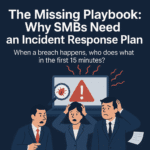
DNS Lookup & Email Security Check
Check DNS records, SPF, DKIM, DMARC, and email security configuration for your domain
Stay ahead of evolving threats with actionable cybersecurity insights, real-world case studies, and expert guidance from Inventive HQ's security team.

Check DNS records, SPF, DKIM, DMARC, and email security configuration for your domain


Master Python’s datetime module with string conversion, formatting, comparisons, and timezone handling examples

Get 24/7 Security Operations Center (SOC) monitoring that catches threats before they become business-ending disasters.

We help B2B SaaS and technology companies achieve SOC 2 Type I and Type II certification in months, not years — turning compliance from a sales blocker into your competitive advantage.

We identify, prioritize, and help you fix security vulnerabilities across your entire infrastructure — before attackers find them.

Learn essential techniques for unpacking and deobfuscating malware, from entropy analysis and manual debugging to automated tools and bypassing anti-analysis protections.

Master the fundamentals of shellcode analysis with this comprehensive guide covering common patterns, encoding techniques, analysis tools, and step-by-step methodologies for security researchers and CTF players.

Master the fundamentals of disassemblers—essential tools for malware analysis, security research, and reverse engineering. Learn how they work, compare top tools like IDA Pro and Ghidra, and discover career opportunities in cybersecurity.

A comprehensive guide to the three major executable file formats - PE (Windows), ELF (Linux/Unix), and Mach-O (macOS). Learn their structure, security implications, and analysis techniques for malware research and reverse engineering.
![Linear Webhooks: Complete Guide with Payload Examples [2025]](https://images.unsplash.com/photo-1460925895917-afdab827c52f?w=1200&h=630&fit=crop)
Complete guide to Linear webhooks with setup instructions, payload examples, signature verification, and implementation code. Learn how to integrate Linear webhooks into your application with step-by-step tutorials for real-time project management automation.

Master webhook signature verification across HMAC-SHA256, HMAC-SHA1, RSA-SHA256, and ECDSA algorithms. Learn implementation patterns, security best practices, and avoid common mistakes with production-ready code examples.

Master local webhook testing with ngrok. Learn how to expose your development server to the internet, inspect webhook payloads, and debug integrations before deploying to production.

Master webhook implementation with battle-tested best practices for security, performance, reliability, and monitoring. From signature verification to dead letter queues, learn how to build production-grade webhook systems that scale.

Learn how the SOLID principles guide modular, maintainable object-oriented systems, with practical examples, review checklists, and tips for avoiding common anti-patterns.
Page 1 of 53 • 794 articles total
Get expert cybersecurity insights, threat intelligence, and best practices to protect your business.